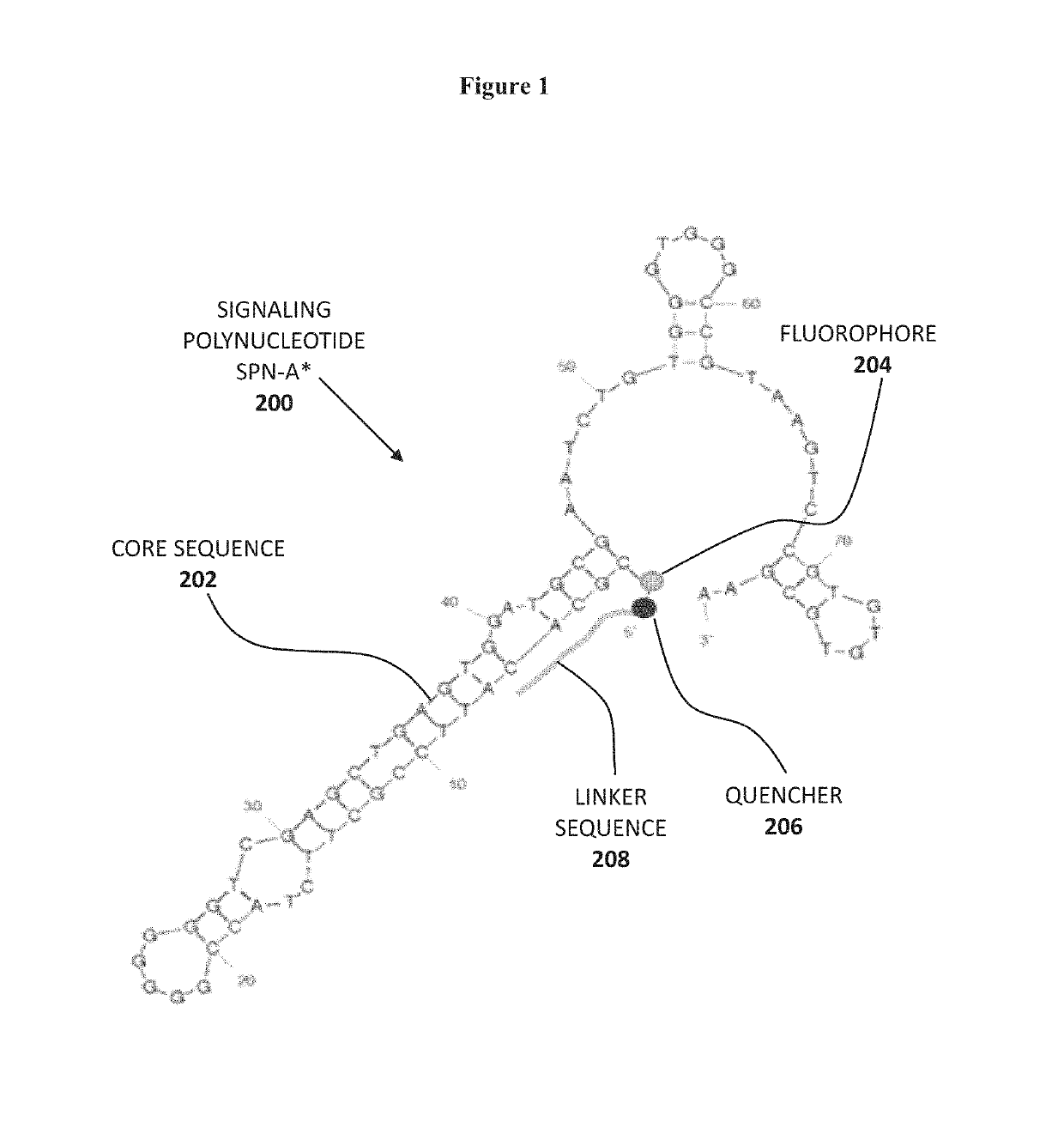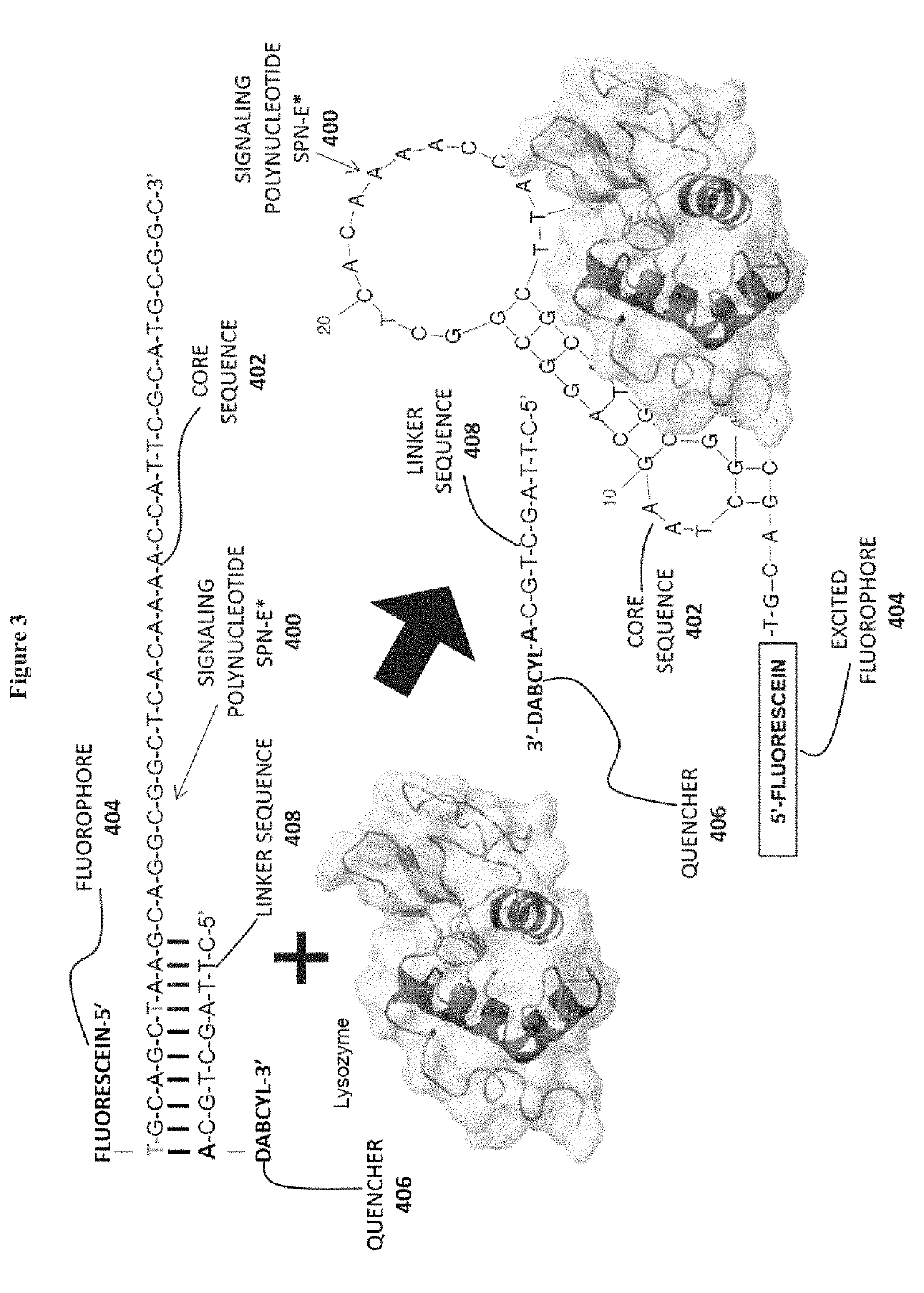Compositions and methods for allergen detection
a signaling polynucleotide and aptamer technology, applied in the direction of peptide/protein ingredients, immunological disorders, instruments, etc., can solve the problems of food allergies, no method for assessing the true allergen content of food, and a large health problem, and achieve the effect of maximum protein extraction
- Summary
- Abstract
- Description
- Claims
- Application Information
AI Technical Summary
Benefits of technology
Problems solved by technology
Method used
Image
Examples
example 1
Design of Aptamers as Signaling Polynucleotides
[0133]In this proof-of-concept example, two previously known aptamer sequences were used to design three different signaling polynucleotides. An aptamer against the Ara h 1 protein allergen is described by Tran et al. in Selection of aptamers against Ara h 1 protein for FO-SPR biosensing of peanut allergens in food matrices. Biosensors and Bioelectronics, 2013, 43, 245-251 (incorporated herein by reference in entirety). The sequence of this aptamer is shown below.
[0134]
(SEQ ID NO: 1)5′CGCACATTCCGCTTCTACCGGGGGGGTCGAGCTGAGTGGATGCGAATCTGTGGGTGGGCCGTAAGTCCGTGTGTGCGAA3′
[0135]The original aptamer of SEQ ID NO: 1 was modified to add a 5′-T residue to improve the functioning of the fluorophore-quencher pair. Fluorescein was then linked to the 5′-T residue as shown below.
[0136]
(SEQ ID NO: 2)5′FluoresceinTCGCACATTCCGCTTCTACCGGGGGGGTCGAGCTGAGTGGATGCGAATCTGTGGGTGGGCCGTAAGTCCGTGTGTGCGAA3′
[0137]A 9-nucleotide linker with a 3′-DABCYL quencher was desi...
example 2
Selection and Optimization of Aptamer Polynucleotides
[0154]An in vitro screening experiment based on SELEX method was carried out and aptamers were selected against the allergen targets including egg, gluten, milk, soy, fish, peanut, cashew and crustacean, over the counter-target (combinations of the non-target proteins) and were further engineered for their capability in detecting targeted food allergens.
Experimental Plan
[0155]Various RNA libraries were used to select for binding ability in selection buffer consisting of 100 mM Tris (pH 8), 5 mM EDTA, 150 mM NaCl, 10 mM MgCl2, 0.1% SDS, 0.1% Gelatin, 1% NP-40 (Tergitol), 0.5% Deoxycholate Sodium at 23° C. A given round of selection began with incubating RNA library members in either the buffer alone (negative selection), then collecting the portion of the library that did not respond (i.e. cleave). The second part of each round (when called for) consisted of incubating the non-responsive molecules from the prior negative selection ...
example 3
Total Protein Measurement
[0165]Total protein measurement is tested using Pyrogallol Red-molybdate (PRM) protein dye-binding assays. PRM is first made in a solution containing 0.156 mM pyrogallol red, 0.209 mM sodium molybdate and 50 mM Tris-HCl. A test plate is prepared by adding 20 μl / well PRM solution and the plate is dry overnight. After processing the test food matrixes, processed sample solution (400 μl) is added to each well and the protein absorbance is read immediately at 600 nm.
PUM
| Property | Measurement | Unit |
|---|---|---|
| fluorescence | aaaaa | aaaaa |
| secondary structure | aaaaa | aaaaa |
| length | aaaaa | aaaaa |
Abstract
Description
Claims
Application Information
 Login to View More
Login to View More - R&D
- Intellectual Property
- Life Sciences
- Materials
- Tech Scout
- Unparalleled Data Quality
- Higher Quality Content
- 60% Fewer Hallucinations
Browse by: Latest US Patents, China's latest patents, Technical Efficacy Thesaurus, Application Domain, Technology Topic, Popular Technical Reports.
© 2025 PatSnap. All rights reserved.Legal|Privacy policy|Modern Slavery Act Transparency Statement|Sitemap|About US| Contact US: help@patsnap.com



